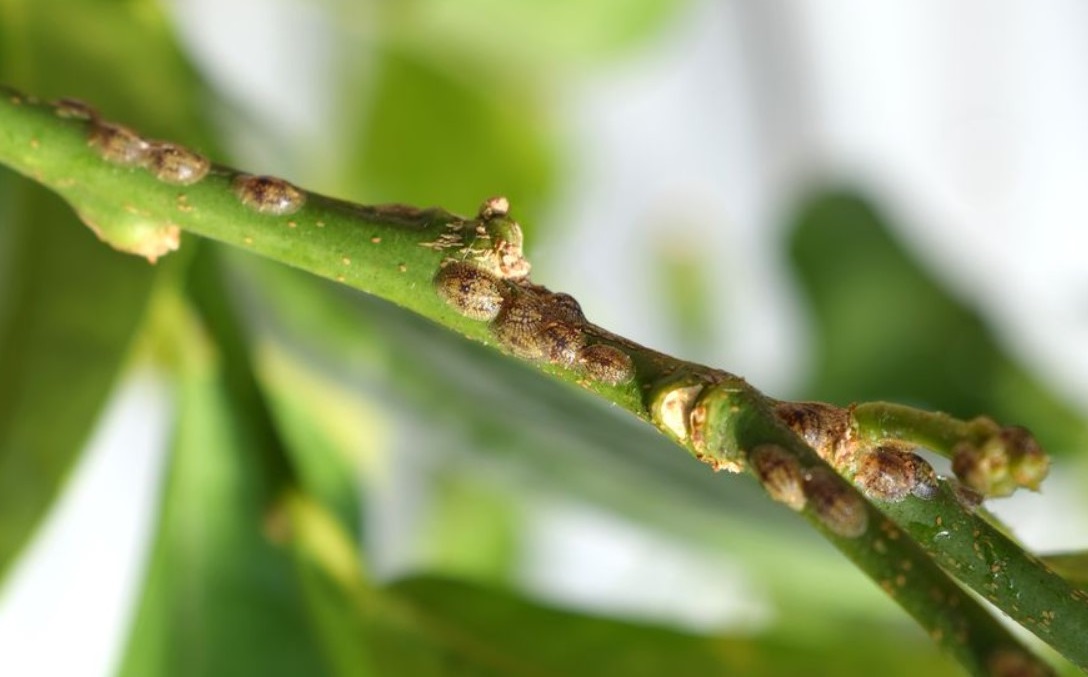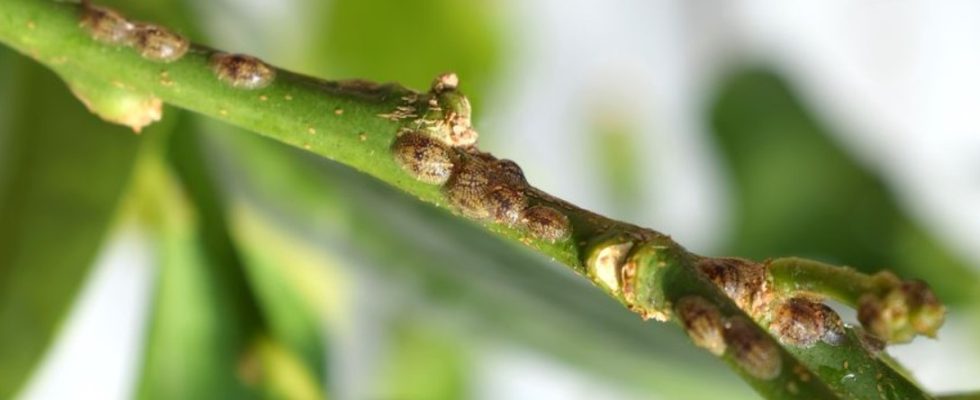
Shelled mealybugs
Formerly called lecanine mealybugsthey belong to the Coccidae family. Shell mealybugs and shield mealybugs are quite similar in terms of their appearance, lifestyle and development, each causes as much damage as the other, and is often referred to under the common term of “shell scale insects”.
Some descriptive elements
In these insects, only males have wings and can be confused with midges. They don’t cause no harm to your plantsto the extent that they do not feed on their sap, but they can, unfortunately, fertilize females over great distances.
The ones who can destroy your plants are the females! The female cochineal has no wings, it has an oval-shaped body covered with a waxy substance of brown, gray, green or transparent color which forms a shell under which it lays hundreds of eggs and whose Domed shape sometimes gives this insect the name “turtle cochineal”.
Neither legs nor antennae emerge from this shell, which means that the cochineal can go completely unnoticed. This shell is one of the differences between shield scales and shell scales. : in the former, it is removable, but not in the latter.
Life cycle
The female therefore lays her eggs under her shell and hatching takes place in the same place. After hatching, the female dies, while the larvae follow several phases of development.
At the first stage of their life, they are tiny, around 0.2 mm, but very mobile: they will even be able to take up residence on another plant to feed on it. Once adults, females settle in one place where they feed, lay eggs, and then die. They can then measure up to 4 mm.
Plants susceptible to shelled mealybugs
Whether indoors or outdoors, your plants can be victims of a mealybug infestation. You should know that shelled scale insects, like other scale insects, particularly appreciate warm and humid environments.
Furthermore, the shelled scale insect family includes many species which are not all fond of the same plants. Here are some examples :
- Indoor plants, such as ficus, orchids, scheffleras, citrus fruits, etc. are very appreciated by Hesperid louse, as well as the greenhouse mealybug.
- Vines, fruit trees, small-fruited shrubs, but also indoor plants can be victims of the dogwood mealybug.
- Hydrangeas, chestnut trees, lime trees, maples, birches, rhododendrons, pines, etc., as well as many ornamental shrubs can fall victim to different Pulvinar mealybugs.
- Cacti and succulents are not safe from an invasion of shelled mealybugs.
Identify the presence of shelled mealybugs
In the early stages of its life, when it is still mobile, the mealybug is so tiny that it is not uncommon for it to go unnoticed.
It is only once it is adult, well established and feeding on the sap of your plants by biting the leaves and stems that you can notice the infestation. That is why it is important to monitor your plants closely so as not to miss the warning signs. Here’s what should arouse your suspicion:
- If you feel like there is a drop of dried sap on your plant or you notice a small growth, do not hesitate to try to remove it. If you can get there easily, it’s a mealybug.
- In the same way, if you notice tiny shiny spots, like scales, on leaves or stems, check! In fact, the shell of the cochineal can glow in the light.
- If you notice drops of a sticky substance on the leaves of your plant, it may be honeydew, a substance secreted by mealybugs.
- You may also notice the presence of sooty mold on the leaves. This is a black micro-fungus that grows on honeydew.
- You may notice that your plant has less vigorthat some of its leaves begin to yellow or deform, then fall.
Preventing the appearance of shelled mealybugs
By adopting several good habits, you can prevent shelled mealybugs from entering your home:
- When you buy a new plant, it is important to examine it carefully. Indeed, it is not uncommon for the invasion to be caused by a newly arrived plant. You can also isolate it for a few days, while you make sure it is not already infested.
- Carry out regular monitoring of all your plants by checking the back of the sheets and all the slightly hidden corners. The presence of honeydew should not be neglected.
- Be sure to disinfect your gardening toolsas well as the pots.
- Make sure you offer good growing conditions to your plants to keep them healthy.
Fight against shelled mealybugs
If you have noticed the presence of mealybugs on one of your plants, you need to act quickly. Here’s what you can do:
- Start by quarantining your plant to prevent it from contaminating other plants.
- If possible, prune your plant properly. to remove as many of these unwanted insects as possible. Once pruning is complete, carefully disinfect the tool used so as not to transfer eggs or larvae to other plants.
- You can then spray a mixture of water and black soap added 1% methylated spirits to the entire plant, making sure to put it on the underside of the leaves. Alcohol has the effect of melting the shell.
- Using an old toothbrush dipped in a mixture consisting of 60 mL of soap diluted in 1 liter of water, scrub the entire plant to remove all the mealybugs. This step is important because protected by its shell, the cochineal can resist spraying. It is therefore essential to drop as much as possible, whether on plants indoors or outdoors. In the case of an infested tree, use a brush and scrub the bark thoroughly.
- Finally, rinse your plant thoroughly.
- Monitor your plant carefully over the following weeks and do not hesitate to repeat the operation if you have the slightest doubt until you get rid of the mealybugs.

